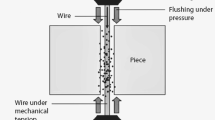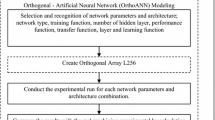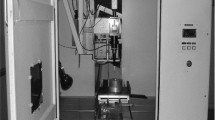Abstract
The work focuses on assessing the optimal machining conditions which could simultaneously satisfy multiple process performance indices during machining of AISI D2 steel. The main characteristic indices that have been considered here for evaluating plasma arc machining are surface roughness and material removal rate; the corresponding machining parameters are cutting speed, gas pressure and torch height. The study proposes an integrated optimization module combining fuzzy inference system, nonlinear regression and JAYA algorithm towards optimizing correlated multi-response features during machining of AISI D2 steel. Optimum value of machining parameters found as cutting speed of 4000 m/min, gas pressure of 95 psi and torch height of 0.5 mm using aforementioned methodology. Application potential of the aforesaid integrated optimization route has been compared to that of teaching–learning based optimization (TLBO) algorithm and genetic algorithm. It has been concluded that JAYA algorithm possesses less convergence time and hence execution is faster as compared to TLBO and genetic algorithm.













Similar content being viewed by others
References
Abhishek K, Datta S, Mahapatra SS (2016) Multi-objective optimization in drilling of CFRP (polyester) composites: application of a fuzzy embedded harmony search (HS) algorithm. Measurement 77:222–239
Abhishek K, Kumar VR, Datta S, Mahapatra SS (2015) Parametric appraisal and optimization in machining of CFRP composites by using TLBO (teaching–learning based optimization algorithm). J Intell Manuf 28:1–17
Adalarasan R, Santhanakumar M, Rajmohan M (2015) Application of Grey Taguchi-based response surface methodology (GT-RSM) for optimizing the plasma arc cutting parameters of 304L stainless steel. Int J Adv Manuf Technol 78:1161–1170
Ali S, Prasad DK, Shankar S, Saw K (2016) Experimental investigation of temperature distribution and surface roughness for cutting aluminium-19000 and stainless steel 304 using plasma arc cutting. Int J Adv Technol Eng Sci 4:153–158
Bhuvenesh R, Saifuldin M, Norizaman MH (2012) Surface roughness and MRR effect on manual plasma arc cutting machining. World Acad Sci Eng Technol 6:465–468
Bini R, Colosimo BM, Kutlu AE, Monno M (2008) Experimental study of the features of the kerf generated by a 200A high tolerance plasma arc cutting system. J Mater Process Technol 196(1):345–355
Chamarthi S, Sinivasa Reddy N, Elipey MK, Ramana Reddy DV (2013) Investigation analysis of plasma arc cutting parameters on the unevenness surface of hardox-400 material. Procedia Eng 64:854–861
Cox E (1992) Fuzzy fundamentals. IEEE Spectr 29(10):58–61
Gariboldi E, Previtali B (2005) High tolerance plasma arc cutting of commercially pure titanium. J Mater Process Technol 160(1):77–89
Harničárová M, Valíček J, Čep R, Tozan H, Müllerová J, Grznárik R (2013) Comparison of non-traditional technologies for material cutting from the point of view of surface roughness. Int J Adv Manuf Technol 69(1–4):81–91
Ilii SM, Coteata M, Munteanu A (2010) Experimental results concerning the variation of surface roughness parameter (Ra) at plasma arc cutting of a stainless steel workpiece. Int J Mod Manuf Technol II(1):31–36
Iosub A, Nagit G, Negoescu F (2008) Plasma cutting of composite materials. Int J Mater Form 1(1):1347–1350
Klimpel A, Cholewa W, Bannister A, Luksa K, Przystałka P, Rogala T, Skupnik D, Cicero S, Martín-Meizoso A (2017) Experimental investigations of the influence of laser beam and plasma arc cutting parameters on edge quality of high-strength low-alloy (HSLA) strips and plates. Int J Adv Manuf Technol 92:1–15
Mamdani EH (1976) Advances in the linguistic synthesis of fuzzy controllers. Int J Man Mach Stud 8(6):669–678
Pawar PJ, Rao RV (2013) Parameter optimization of machining processes using teaching–learning based optimization algorithm. Int J Adv Manufact Technol 67(5):995–1006
Rao R (2016) Jaya: a simple and new optimization algorithm for solving constrained and unconstrained optimization problems. Int J Ind Eng Comput 7(1):19–34
Rao RV, Kalyankar VD (2013) Multi-pass turning process parameter optimization using teaching–learning-based optimization algorithm. Sci Iran 20(3):967–974
Rao RV, Kalyankar VD (2013) Parameter optimization of modern machining processes using teaching–learning-based optimization algorithm. Eng Appl Artif Intell 26(1):524–531
Rao RV, More KC, Taler J, Ocłoń P (2016) Dimensional optimization of a micro-channel heat sink using Jaya algorithm. Appl Therm Eng 103:572–582
Schnick M, Fussel M, Zscetzsche J (2006) Simulation of plasma and shielding gas flows in welding and cutting arcs with ansys CFX. Int Sci Colloq Model Mater Process 1:143–148
Singh V (2012) Analysis of process parameters of plasma arc cutting using design of experiment. Doctoral dissertation
Tsiolikas A, Kechagias J, Salonitis K, Mastorakis N (2016) Optimization of cut surface quality during CNC Plasma Arc Cutting process. Int J Syst Appl Eng Dev 10:305–308
Verma RK, Abhishek K, Datta S, Mahapatra SS (2011) Fuzzy rule based optimization in machining of FRP composites. Turk J Fuzzy Syst 2(2):99–121
Xu WJ, Fang JC, Lu YS (2002) Study on ceramic cutting by plasma arc. J Mater Process Technol 129(1):152–156
Yamaguchi Y, Katada Y, Itou T, Uesugi Y, Tanaka Y, Ishijima T (2015) Experimental investigation of magnetic arc blow in plasma arc cutting. Weld World 59(1):45–51
Zadeh LA (1965) Fuzzy sets. Inf Control 8(3):338–353
Zhou B, Liu YJ, Tan SK (2013) Efficient simulation of oxygen cutting using a composite heat source model. Int J Heat Mass Transf 57(1):304–311
Author information
Authors and Affiliations
Corresponding author
Additional information
Technical Editor: Márcio Bacci da Silva.
Rights and permissions
About this article
Cite this article
Patel, P., Nakum, B., Abhishek, K. et al. Machining performance optimization during plasma arc cutting of AISI D2 steel: application of FIS, nonlinear regression and JAYA optimization algorithm. J Braz. Soc. Mech. Sci. Eng. 40, 240 (2018). https://doi.org/10.1007/s40430-018-1087-7
Received:
Accepted:
Published:
DOI: https://doi.org/10.1007/s40430-018-1087-7




